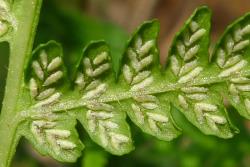Terrestrial or rupestral ferns (NZ) or sometimes rheophytic (not NZ). Rhizomes short- to long-creeping or erect, scaly (NZ) and sometimes also hairy (not NZ). Fronds monomorphic, not articulated to rhizome. Laminae entire to 4-pinnate, anadromous or catadromous, herbaceous to coriaceous, scaly and sometimes hairy. Veins free or rarely anastomosing. Sori elongated along veins and either single or paired back-to-back or bent across the vein at one end or horseshoe-shaped (NZ) or rarely round (not NZ), borne on abaxial surface away from margins; receptacles flat; paraphyses absent; indusia present, same shape as the sori, opening away from the vein; sporangial maturation mixed. Sporangia with vertical annulus, usually 64 spores per sporangium. Homosporous; spores monolete, lacking chlorophyll; perispores nearly plain to coarsely tuberculate, echinate or folded.
A family of 3 genera and about 650 species (PPG 1 2016).
Rothfels et al. (2012) undertook a family-level classification for the eupolypod II clade of leptosporangiate ferns, one of two major clades within the eupolypod ferns that, together with Lindsaeaceae, Saccolomataceae, Dennstaedtiaceae, and Pteridaceae, make up the Polypodiales. Rothfels et al. (2012) argued that the eupolypod II clade was one of the few that was still poorly understood at the time of the classification proposed by Smith et al. (2006), and they therefore presented a new classification derived largely from published molecular studies.
Athyriaceae was previously included by Kramer (1990) within the subfamily Athyrioideae in a very broadly construed Dryopteridaceae. Smith et al. (2006) separated Dryopteridaceae from Woodsiaceae, the latter comprising both the woodsioid and athyrioid ferns. Pichi Sermolli (1977) and Wang et al. (2003) further sub-divided Athyriaceae, distinguishing Woodsia and its segregates as a much-reduced Woodsiaceae. Rothfels et al. (2012) went even further and subdivided Athyriaceae into five families, separating off four small groups from the much larger Athyriaceae. These included Cystopteridaceae, Diplaziopsidaceae, Rhachidosoraceae, and Hemidictyaceae, which were in many respects somewhat closer to Aspleniaceae.
Five genera, Anisocampium, Athyrium, Cornopteris, Deparia, and Diplazium, were recognised within Athyriaceae by Rothfels et al. (2012), but this was reduced to just three by PPG 1 (2016). Although Wei et al. (2018) subsequently reinstated Anisocarpium and Cornopteris, and resurrected Pseudathyrium, in order to recognise monophyletic taxa within the family, we prefer to accept just the three large genera of PPG 1.
The three genera, Athyrium, Deparia, and Diplazium, occur in New Zealand. Deparia is distinguished by the U-shaped groove on the adaxial surface of the rachis, which is not open and confluent with the grooves of the pinna costae. In New Zealand it is also distinguished by having both hairs and scales on the laminae. Diplazium is distinct from Athyrium in having a U-shaped rachis groove, and sori that are linear and either single or sometimes paired back-to-back, whereas Athyrium has a V-shaped rachis groove and sori that are J-shaped, horseshoe-shaped or linear. Athyrioid ferns are sister to the diplazioid ferns, and together they are sister to the deparioid ferns (Rothfels et al. 2012).
| 1 | Laminae scaly and hairy; groove on adaxial surface of rachis not open and confluent with grooves of pinna costae | Deparia |
| Laminae scaly or glabrous but not hairy; groove on adaxial surface of rachis open and confluent with grooves of pinna costae | 2 | |
| 2 | Groove on adaxial surface of rachis V-shaped; sori linear, single on veins, or bent across the vein at one end, not paired back-to-back; rhizomes always erect; veins always free | Athyrium |
| Groove on adaxial surface of rachis U-shaped; sori linear, either single or paired back-to-back along veins; rhizomes erect or rarely long-creeping; veins free or rarely anastomosing | Diplazium |
The family Athyriaceae comprises terrestrial ferns that are most easily recognised by their elongated sori arranged singly or back-to-back along the veins, or bent across the vein at one end (J-shaped). The fronds bear non-clathrate scales and the adaxial rachis is grooved. Athyriaceae is distinguished from Aspleniaceae by its non-clathrate scales, base chromosome number of x = 40 or 41 rather than 36, and often by its sori when they are arranged back-to-back or bent across the veins rather than confined to one side of the vein as in Aspleniaceae.
A subcosmopolitan family, but less common in south temperate regions than in the tropics and north temperate zone. Two non-endemic genera and one naturalised genus in New Zealand with six species; none endemic.
| Category | Number |
|---|---|
| Indigenous (Non-endemic) | 2 |
| Exotic: Fully Naturalised | 1 |
| Exotic: Casual | 3 |
| Total | 6 |




